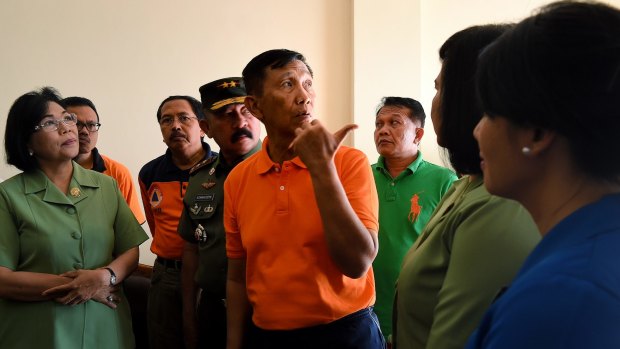This was published 6 years ago
Bali volcano evacuees from outside 'danger zone' told to return home
By Jewel Topsfield and Amilia Rosa
Almost 2400 evacuees who fled the area surrounding Mount Agung volcano in eastern Bali have returned home as authorities stress it is safe for those who live outside the danger zone to return to their villages.
Bali Governor I Made Mangku Pastika emphasised that no one who felt afraid of the volcano would be forced to return home: "If they still feel they are in danger, they are welcome to stay."
However he said it was only necessary for about 70,000 people from 28 villages to have evacuated — about half the total number of 141,399 evacuees.
"To all who live within the 50 villages in the safe zone, if they want to go home, they are welcome to go home, their home is safe. They have their lives there, they have their animals there, who will care for them if they leave for a long period of time?"

The Governor of Bali I Made Mangku Pastika (centre) on Sunday.Credit: Kate Geraghty
Many Balinese people, including survivors of the 1963 eruption of Mount Agung, which killed more than 1500 people, have been spooked by the hundreds of tremors rattling the area every day.
Mount Agung, a volcano in eastern Bali about 72 kilometres from the tourism hotspot of Kuta, has been on the highest possible alert since September 22, after intensifying seismic activity pushed molten rock known as magma towards the surface.
Pillars of white steam have been emitting from the craters at heights of up to 500 metres.
Authorities have erected 54 signs around the danger zone, which is between nine and 12 kilometres from the summit, warning the public they are about to enter a hazardous area.
There are also six mobile sirens, which can be heard for at least two kilometres, which will be activated if Mount Agung erupts.
Mr Pastika said the evacuees from within the danger zone would be provided with ID, which would allow them to continue to access food and other supplies.
"If there are people outside the 28 villages who feel they are in danger, we will provide them with ID too, although I am sure no one will."
Meanwhile Mr Pastika warned civil servants from the Mount Agung area will have their pay docked if they don't return to work on Monday, with temporary offices set up in safe areas.
He said he saw civil servants in Denpasar, Bali's capital, whose car number plates indicated they were from the Karangasem Regency, where Mount Agung is located.
"The civil servants fled to Denpasar - if tomorrow [Monday] they don't return, don't pay their salary," Mr Pastika said at the command post in Tanah Ampo, a ferry terminal that has been transformed into a supplies and logistics centre.
"Just tell them to go, that they are taking advantage, they are holidaying. If they are on duty [and have to be in Denpasar], that's fine. But they parked in front of a hotel, they slept there."
On Wednesday Fairfax Media watched volunteers help relocate civil servants' desks from a sub district office in Kubu inside the danger zone to West Tianyar, which is considered safe.
National Disaster Management Agency spokesman Sutopo Purwo Nugroho warned heat clouds had temperatures of 600 to 800 degrees celsius and could speed down mountain slopes at between 200 and 300 kilometres per hour.
Heat clouds, also known as pyroclastic flows, are a fast moving current of hot gas and volcanic matter that were responsible for many of the more than 1500 deaths when Mount Agung last erupted in 1963.
"Of course they are dangerous for the community if people are within the (danger zone) radius," Mr Sutopo said.
Balinese authorities have warned anyone who visits the peak of Mount Agung volcano is putting lives at risk after a group of priests trekked to the smouldering summit to make offerings on Friday.
One of the priests, Jero Mangku Ada, told Fairfax Media a God spoke to him when he was staying at an evacuation centre in Puri Boga and told him to go up and make an offering.
Videos, taken by another priest, of roaring pillars of steam rising from a crater have been posted on Facebook. They have attracted thousands of comments and shares, with some criticising the priests for being irresponsible and potentially encouraging copycats and others sending their blessings.